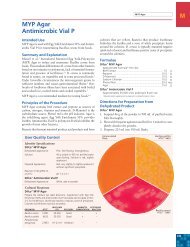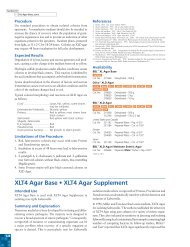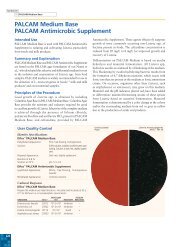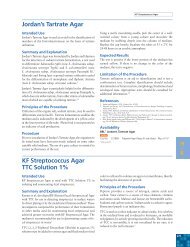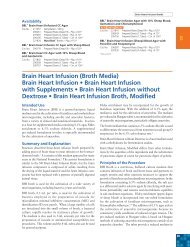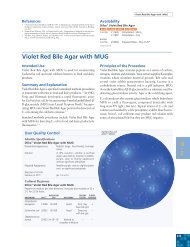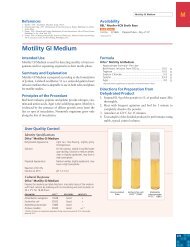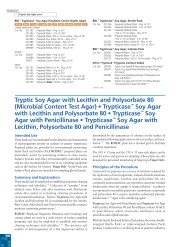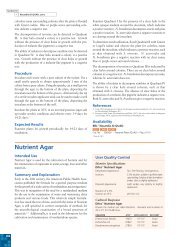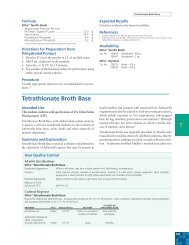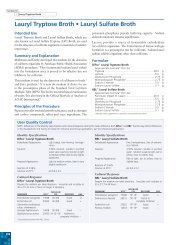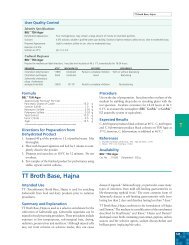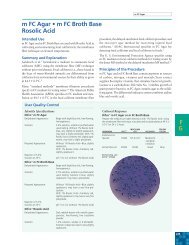MacConkey Agars MacConkey Agar ⢠MacConkey ... - BVA Scientific
MacConkey Agars MacConkey Agar ⢠MacConkey ... - BVA Scientific
MacConkey Agars MacConkey Agar ⢠MacConkey ... - BVA Scientific
You also want an ePaper? Increase the reach of your titles
YUMPU automatically turns print PDFs into web optimized ePapers that Google loves.
Section IIIM <strong>MacConkey</strong> <strong><strong>Agar</strong>s</strong>, cont.References1. Bopp, Brenner, Wells and Strockbine. 1999. In Murray, Baron, Pfaller, Tenover and Yolken (ed.),Manual of clinical microbiology, 7th ed. American Society for Microbiology, Washington, D.C.2. Flowers, Andrews, Donnelly and Koenig. 1993. In Marshall (ed.), Standard methods for theexamination of dairy products. 16th ed., American Public Health Association, Washington, D.C.3. Downes and Ito (ed.). 2001. Compendium of methods for the microbiological examination of foods,4th ed. American Public Health Association, Washington. D.C.4. U.S. Food and Drug Administration. 1995. Bacteriological analytical manual, 8th ed. AOAC International,Gaithersburg, Md.5. Clesceri, Greenberg and Eaton (ed.). 1998. Standard methods for the examination of water andwastewater, 20th ed. American Public Health Association, Washington, D.C.6. United States Pharmacopeial Convention, Inc. 2001. The United States pharmacopeia 25/Thenational formulary 20 – 2002. United States Pharmacopeial Convention, Inc., Rockville, Md.7. Horwitz (ed.). 2000. Official methods of analysis of AOAC International, 17th ed. AOAC International,Gaithersburg, Md.8. <strong>MacConkey</strong>. 1905. J. Hyg. 5:333.9. Kent and Kubica. 1985. Public health mycobacteriology: a guide for the level III laboratory. USDHHS,Centers for Disease Control, Atlanta, Ga.10. Master. 1994. In Isenberg (ed.), Clinical microbiology procedures handbook, vol. 1, suppl. 1. AmericanSociety for Microbiology, Washington, D.C.11. Mazura-Reetz, Neblett and Galperin. 1979. Abstr. C179, p. 339. Abstr. Annu. Meet. AmericanSociety for Microbiology 1979.AvailabilityDifco <strong>MacConkey</strong> <strong>Agar</strong>AOAC BAM CCAM COMPF EP SMD SMWW USPCat. No. 212123 Dehydrated – 500 g212122 Dehydrated – 2 kg275300 Dehydrated – 10 kgBBL <strong>MacConkey</strong> <strong>Agar</strong>AOAC BAM CCAM COMPF EP SMD SMWW USPCat. No. 211387 Dehydrated – 500 g211390 Dehydrated – 5 lb (2.3 kg)211391 Dehydrated – 25 lb (11.3 kg)Difco <strong>MacConkey</strong> <strong>Agar</strong> BaseCat. No. 281810 Dehydrated – 500 gDifco <strong>MacConkey</strong> <strong>Agar</strong> without Crystal VioletCat. No. 247010 Dehydrated – 500 gBBL <strong>MacConkey</strong> <strong>Agar</strong> without Crystal VioletCat. No. 211393 Dehydrated – 500 gEuropeCat. No. 256008 Prepared Plates – Pkg. of 20*BBL <strong>MacConkey</strong> <strong>Agar</strong> without Crystal Violet or SaltCat. No. 294584 Dehydrated – 500 g297901 Prepared Plates – Ctn. of 100*Difco <strong>MacConkey</strong> <strong>Agar</strong> without SaltCat. No. 233120 Dehydrated – 500 g233110 Dehydrated – 10 kgEuropeCat. No. 256009 Prepared Plates – Pkg. of 20**Store at 2-8°C.<strong>MacConkey</strong> II <strong>Agar</strong> • <strong>MacConkey</strong> II <strong>Agar</strong> with MUG338Intended Use<strong>MacConkey</strong> II <strong>Agar</strong> conforms with specifications of The UnitedStates Pharmacopeia (USP).<strong>MacConkey</strong> II <strong>Agar</strong> is a slightly selective and differential mediumfor the detection of coliform organisms and enteric pathogens.<strong>MacConkey</strong> II <strong>Agar</strong> with MUG is used for the presumptiveidentification of Escherichia coli.Summary and ExplanationThe BBL <strong>MacConkey</strong> II <strong>Agar</strong> formulation was made availablein 1983. It was specially designed to improve the inhibitionof swarming Proteus species, to achieve more definitive differentiationof lactose fermenters and nonfermenters, and for thepromotion of superior growth of enteric pathogens.Trepeta and Edberg 1 modified <strong>MacConkey</strong> <strong>Agar</strong> by the incorporationof MUG (4-methylumbelliferyl-β-D-glucuronide). Theresulting medium allowed the authors to presumptivelyidentify E. coli from the primary plating medium within 5minutes.Principles of the Procedure<strong>MacConkey</strong> II <strong>Agar</strong> is a selective and differential medium. Itis only slightly selective since the concentration of bile salts,which inhibit gram-positive microorganisms, is low in comparisonwith other enteric plating media. Crystal violet also isincluded in the medium to inhibit the growth of gram-positivebacteria, especially enterococci and staphylococci.Differentiation of enteric microorganisms is achieved bythe combination of lactose and the neutral red indicator.Colorless or pink to red colonies are produced depending uponthe ability of the isolate to ferment the carbohydrate.Most strains (96-97%) of E. coli produce β-D-glucuronidase. 2The enzyme hydrolyzes MUG to yield 4-methylumbelliferone,a compound that fluoresces under long-wave (366 nm)UV light. The addition of MUG to the formulation allowsβ-D-glucuronidase-positive strains of E. coli to fluoresceblue-green when examined under UV light.BBL <strong>MacConkey</strong> II <strong>Agar</strong> with MUG contains 0.1 g of MUGper liter of <strong>MacConkey</strong> II <strong>Agar</strong>.FormulaBBL <strong>MacConkey</strong> II <strong>Agar</strong>Approximate Formula* Per LiterPancreatic Digest of Gelatin ..................................... 17.0 gPancreatic Digest of Casein ........................................ 1.5 gPeptic Digest of Animal Tissue ................................... 1.5 gLactose ..................................................................... 10.0 gBile Salts ..................................................................... 1.5 gSodium Chloride ........................................................ 5.0 g<strong>Agar</strong> ......................................................................... 13.5 gNeutral Red ................................................................ 0.03 gCrystal Violet .............................................................. 1.0 mg*Adjusted and/or supplemented as required to meet performance criteria.Directions for Preparation fromDehydrated Product1. Suspend 50 g of the powder in 1 L of purified water. Mixthoroughly.2. Heat with frequent agitation and boil for 1 minute tocompletely dissolve the powder.3. Autoclave at 121°C for 15 minutes.4. Test samples of the finished product for performance usingstable, typical control cultures.



